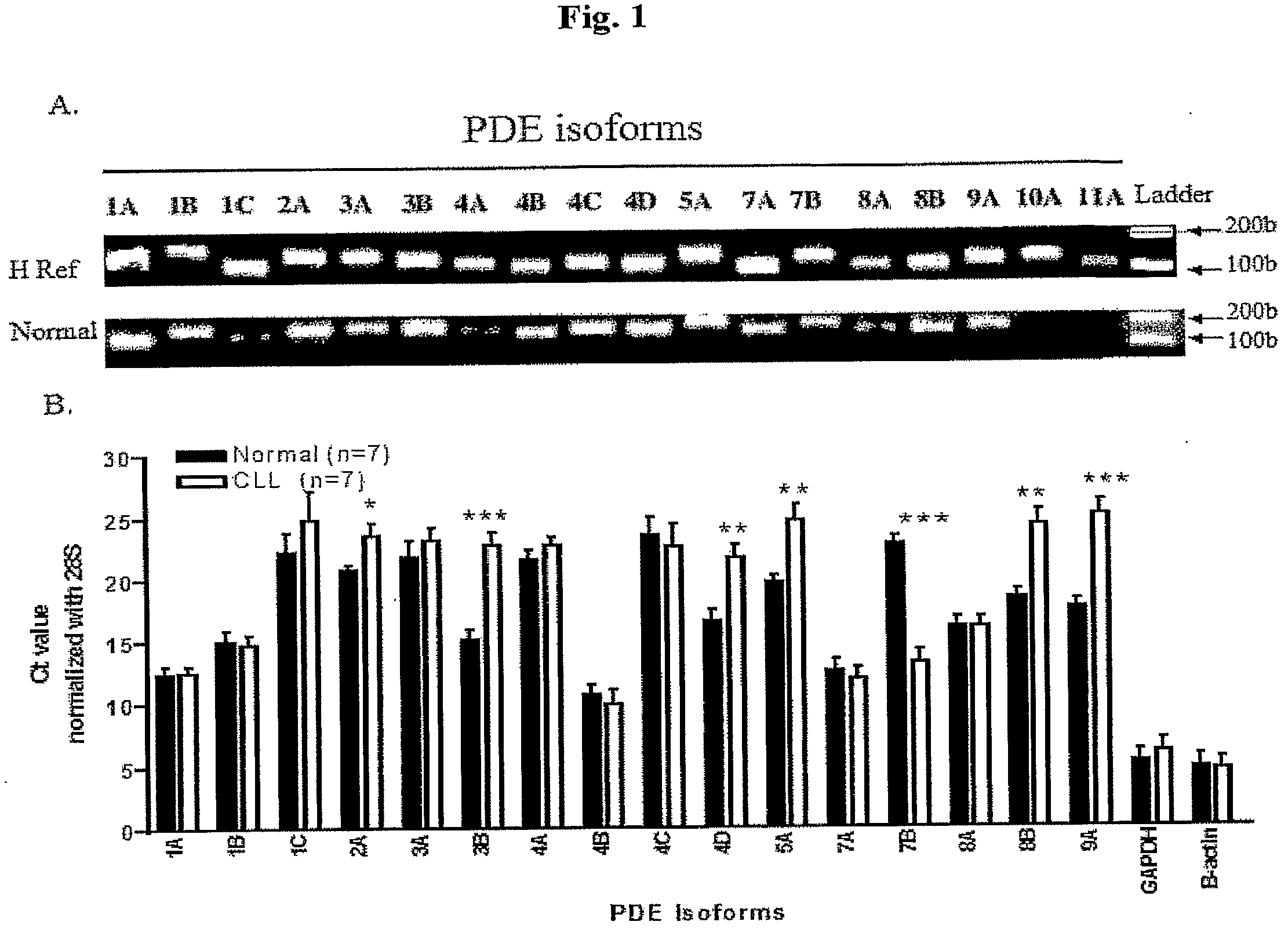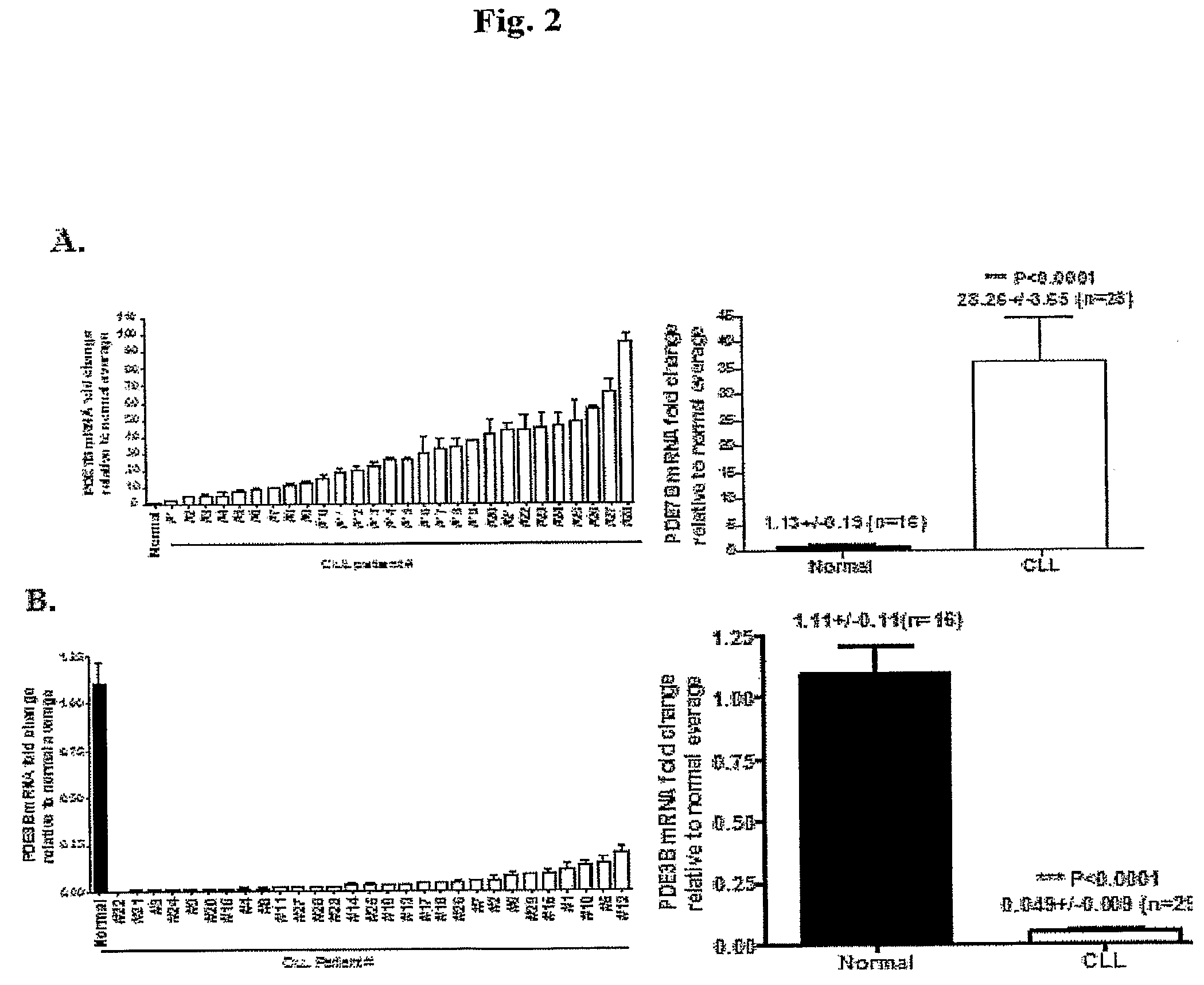Diagnosis and Treatment of Chronic Lymphocytic Leukemia (CLL)
a lymphocytic leukemia and chronic lymphocytic leukemia technology, applied in the field of chronic lymphocytic leukemia diagnosis and treatment, can solve the problems of limited treatment options for patients with cll, failure of bone marrow, and suppression of the immune system, so as to achieve significant protein expression in cll patients and significant increase in expression levels
- Summary
- Abstract
- Description
- Claims
- Application Information
AI Technical Summary
Benefits of technology
Problems solved by technology
Method used
Image
Examples
example 1
PDE Isoforms Expression Profile in PBMCs from CLL Patients and Normal Subjects
[0070]The mRNA expression of PDE isoforms were examined by RT-PCR and QPCR. Two sets of primers specific for 18 PDE isoforms and 28S rRNA (yielding either 100-200 bp or 300-400 bp PCR products) were validated against human QPCR reference total RNA (FIG. 1A shows a representative gel using the shorter set of primers). Using these primers, it was found that PBMC from normal subjects and CLL patients express mRNA for multiple PDE isoforms; PDE1A, 1B, 1C, 2A, 3A, 3B, 4A, 4B, 4C, 4D, 7A, 7B, 8A, 8B, and 9A (FIG. 1A-1B); mRNAs for PDE10A and PDE11A in normal- or CLL-PBMC were not detected in PBMCs from both normal subjects and CLL patients (FIG. 1A).
[0071]PBMCs from 7 CLL patients and 7 normal subjects were also tested using QPCR to determined if CLL was associated with altered PDE isoform expression. Although Ct can be influenced by primer efficiency, one can extrapolate quantitative information from Ct values ...
example 2
Increased PDE7B mRNA and Protein Expressions and PDE7 Activity with CLL
[0072]The mRNA expression of PDE7B in further 22 CLL-PBMC (total n=29) and 9 normal-PBMC (total n=16) was assessed using QPCR. It was found that PDE7B mRNA was increased from 2.9 to 95.7-fold (mean, 28.26±3.65, FIG. 2A) in CLL-relative to normal-PBMC. In addition to the increase in PDE mRNA expression, PDE7B protein expression was increased in CLL-PBMC compared to normal-PBMC (FIG. 5A shows a representative immunoblot). Densitometric analysis revealed 20-fold increase in PDE7B protein expression in CLL (FIG. 5B: CLL, n=10, normal n=3, samples from 2 other normal subjects had PDE7B protein expression levels below the levels of detection). In addition, using the only commercially available specific PDE7 inhibitor, BRL-50481 [3-(N,N-dimethylsulfonamido)-4-methyl-nitrobenzene], an increased contribution of PDE7 to total cAMP-PDE activity in CLL-versus normal-PBMC was found (FIG. 5C).
[0073]Therefore, these data show t...
example 3
Decreased PDE3B mRNA Expression with CLL
[0075]The mRNA expression of PDE3B in the same 22 CLL-PBMC (total h=29) and 9 normal-PBMC assessed using QPCR. A prominent decrease in the mRNA expression of PDE3B in CLL-relative to normal-PBMC was found (0.003 to 0.197-fold, 0.049±0.009, FIG. 2B, relative to levels in normals). PDE3B, the dominant PDE3 in lymphocytes, hydrolyzes cAMP; the cAMP hydrolytic activity of PDE3 is inhibited by cGMP, thereby integrating response to the two cyclic nucleotide (29). Consistent with the data shown herein that PDE3B expression is decreased in CLL, the PDE3 inhibitor, cilostamide, does not induce apoptosis in CLL-PBMC, implying that this PDE is not a useful therapeutic target in this disease (13). Further investigation of the transcriptional control of PDE3B may provide mechanistic insights regarding its decreased expression in CLL.
[0076]Activation of cAMP-response element-binding (CREB) proteins appears to be essential for the induction of PDE3B mRNA (30...
PUM
| Property | Measurement | Unit |
|---|---|---|
| enzyme activity | aaaaa | aaaaa |
| weight loss | aaaaa | aaaaa |
| mass | aaaaa | aaaaa |
Abstract
Description
Claims
Application Information
 Login to View More
Login to View More - R&D
- Intellectual Property
- Life Sciences
- Materials
- Tech Scout
- Unparalleled Data Quality
- Higher Quality Content
- 60% Fewer Hallucinations
Browse by: Latest US Patents, China's latest patents, Technical Efficacy Thesaurus, Application Domain, Technology Topic, Popular Technical Reports.
© 2025 PatSnap. All rights reserved.Legal|Privacy policy|Modern Slavery Act Transparency Statement|Sitemap|About US| Contact US: help@patsnap.com



